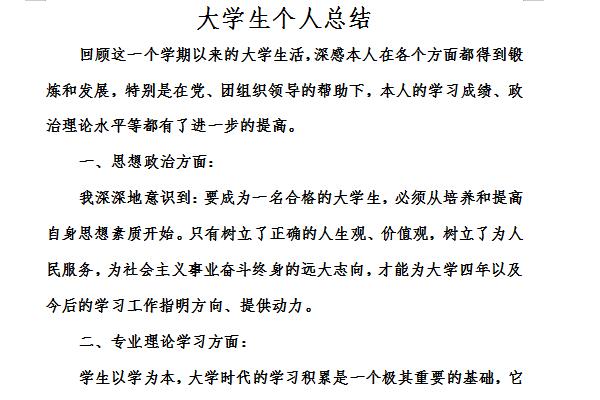
Personal summary content of annual appraisal form for college students
1. Preface. That is, at the beginning of the text, it usually briefly summarizes the basic situation, explains the background, points out the main purpose or explains the achievements, and lays the necessary foundation for the development of the main content. For example: "The key to whether the masses are rich or not depends on the branch; the key to whether the cadres are strong or not depends on the squad leader." The ability to properly select and match the “top leaders” of the branch is the core of strengthening the construction of rural grassroots party organizations. At work, we actively focus on the construction of the branch team, firmly grasp the key of preparing branch secretaries, focus on the three steps of "selecting people", "educating people" and "employing people", and strive to lead the work to the right direction. Go deep.
2. Subject. This is the core part of the summary, which includes practices and experiences, achievements and problems, experiences and lessons learned, etc. This part requires a profound and thorough analysis of the reasons, conditions, practices, and root causes and lessons of existing problems on the basis of a comprehensive review of the work situation, and reveal the regularities in the work. The review should be comprehensive and the analysis should be thorough.
3. Ending. You can summarize the full text, explain the effects of good experience, and propose directions for future efforts or suggestions for improvement. For example: through the above work, the branch secretary and the team as a whole can play their role. Many village branch secretaries have proposed that "serving one term will make you rich." ”, and a group of advanced examples of branch secretaries who “leave the small family behind and take care of everyone” have also emerged.
Notes on Personal Summary of Annual Appraisal Form for College Students
(1) First of all, we must have a realistic attitude. In work summaries, there are often two tendencies: one is to be overjoyed and exaggerated, only talking about achievements and not problems; the other is to write the summary as a "reflection" and describe the work as useless. Neither of these is a realistic attitude. The summary should be based on analyzing and evaluating one's work truthfully and in two parts. Do not exaggerate the achievements; do not understate the problems.
(2) The summary should be written with theoretical value. On the one hand, we must grasp the main contradictions, and do not cover everything whether we talk about achievements or existing problems. On the other hand, we should conduct an in-depth and detailed analysis of the main contradictions. When talking about achievements, we should write down how we did it, why we did it, what the effect was, and what our experience is; when talking about existing problems, we should write down clearly what the problem is and why this happened. What is the problem, what is its nature, and what are the lessons. Only with such a summary can we reflect on the work in the previous period and rise from perceptual understanding to rational understanding.
(3) The summary should be in the first person. That is to say, it should be written from the perspective of this unit and department. The expression method is mainly narrative and discussion, supplemented by explanation, which can be mixed with narrative and discussion.
(4) The summary should pay attention to the audience of the summary, that is, the readers or users of the summary. The first audience of the summary is the writer of the summary. This will first help the author understand the summarized experiences and lessons, achievements and mistakes. But the summary should also take care of other audiences for the summary. For example, if the main audience for the summary of technical employees is market personnel or other leaders who do not understand technology, then in the summary process, they should try to use language that the readers can understand, rather than purely technical terms. Another example is a department manager's department work summary. The language used must take into account the knowledge range of the department's employees (such as company financial secrets, etc.) and the superior manager's knowledge range, and even separate them. Write.
The editor recommends:
The personal summary of the annual appraisal form for college students is a free template. You can download the source file for you to edit, modify and replace. Huajun Software Park also providesTeacher annual work summary sample,A complete collection of weekly summary essaysdownload.






































it works
it works
it works